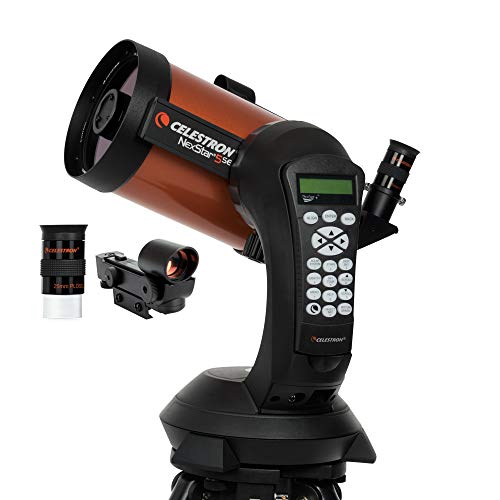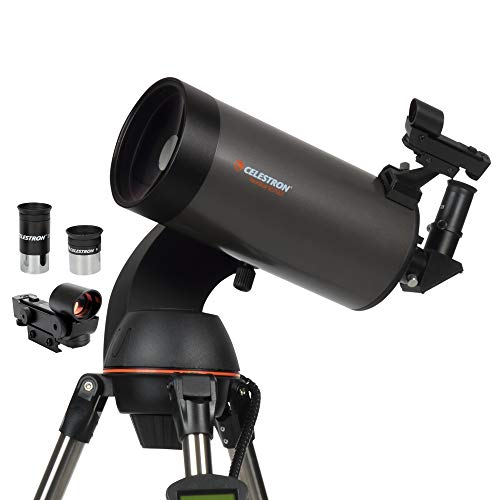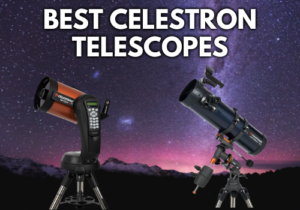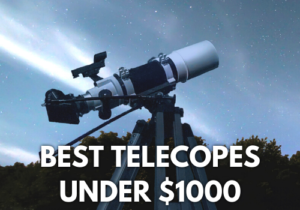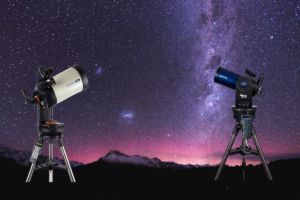5 Best Computerized GoTo Telescopes Under $1000; Reviews
Disclosure: This post contains affiliate links and I may earn a small commission (at no extra cost to you) if you click through and make a purchase. Thanks in advance – I really appreciate it!
Looking for the best computerized GoTo telescope under $1000? That’s an excellent price point to find a high-tech telescope paired with a GPS and computer system without breaking the bank.
A computerized telescope, often known as a GoTo telescope, is any telescope that employs computer technology to locate and “go-to” a celestial object.
Computerized telescope databases include thousands of objects, and depending on the aperture of your telescope optics, you can visit a wide collection of huge galaxies, nebulae, and other amazing sky objects with a simple click of a few buttons.
In this article, we share our opinion of the 5 best GoTo telescopes under 1000 dollars. You’ll definitely want to check these out before making your next purchase.
Best Computerized Telescopes Under $1000
Comparison Table
| Image | Title | Price | Buy |
|---|---|---|---|
 | Celestron - NexStar 5SE Telescope - Computerized Telescope for Beginners and Advanced Users - Fully-Automated GoTo Mount - SkyAlign Technology - 40,000+ Celestial Objects - 5-Inch Primary Mirror | See on Amazon | |
 | Celestron - NexStar 127SLT Computerized Telescope - Compact and Portable - Maksutov-Cassegrain Optical Design - SkyAlign Technology - Computerized Hand Control - 127mm Aperture | See on Amazon | |
 | Celestron - NexStar 4SE Telescope - Computerized Telescope for Beginners and Advanced Users - Fully-Automated GoTo Mount - SkyAlign Technology - 40,000+ Celestial Objects - 4-Inch Primary Mirror | See on Amazon | |
 | Celestron - NexStar 130SLT Computerized Telescope - Compact and Portable - Newtonian Reflector Optical Design - SkyAlign Technology - Computerized Hand Control - 130mm Aperture | See on Amazon | |
 | Celestron - NexStar 6SE Telescope - Computerized Telescope for Beginners and Advanced Users - Fully-Automated GoTo Mount - SkyAlign Technology - 40,000 plus Celestial Objects - 6-Inch Primary Mirror | See on Amazon |
Product prices and availability are accurate as of the date/time indicated and are subject to change. Any price and availability information displayed on [relevant Amazon Site(s), as applicable] at the time of purchase will apply to the purchase of this product.
Prices pulled from the Amazon Product Advertising API on:Top GoTo Telescopes Under $1000 - Reviews
1. Celestron - NexStar 5SE
- 5-Inch aperture: The 5-inch primary mirror in this Schmidt-Cassegrain telescope for adults and kids to be used together packs enough light-gathering ability to observe the best that our Solar System has to offer, while retaining a compact form factor.
- Fully-automated go to mount: Featuring a database of more than 40,000 celestial objects, the go to mount built into our telescopes for astronomy beginners automatically locates and tracks objects for you. Tracking Rates-Sidereal, Solar and Lunar. Tracking Modes-Alt-Az, EQ North & EQ South
- Easy to assemble and break down
- Bonus free starry night softw
Prices pulled from the Amazon Product Advertising API on:
Product prices and availability are accurate as of the date/time indicated and are subject to change. Any price and availability information displayed on [relevant Amazon Site(s), as applicable] at the time of purchase will apply to the purchase of this product.
Specifications
- Optical design: Schmidt-Cassegrain
- Aperture: 5 inch (125mm)
- Focal length: 1250mm
- Focal ratio: f/10
- Optical tube length: 330mm
- Total kit weight: 8kg
- Includes: Optical tube, single-arm fork mount, steel tripod, red-dot finderscope, NexStar+ hand controller, 25mm eyepiece, star diagonal
- Power: 8xAA batteries, 12V external source
NexStar 5SE can achieve what most astronomers want from a GoTo telescope; space objects on demand without the effort of locating.
NexStar 5SE is a planetary performer at its core. It has an f/10 focal ratio. The light travels the optical tube two times instead of one.
As a result, the optics are effortless to focus at high magnifications. It easily gathers detail from the Solar System objects.
Given that it costs less than 1000 dollars – for which you get the OTA, computerized altitude-azimuth single fork mount, sturdy steel tripod, StarPointer red-dot finder, a 1.25-inch star diagonal and a 25mm eyepiece – and size, the NexStar 5SE makes a perfect telescope for both newcomers to skywatching as well as the traveling astronomer.
You can read my full Celestron NexStar 5SE review here. (Opens in new tab)
Why We Recommend It
This telescope comes with a hand controller that has a database of 40,000 sky objects. Although the 5-inch aperture of this telescope is not big enough to show you many of those sky objects, however, it can show you many planets, the moon, and brighter DSOs.
Some of the easy things to observe are Jupiter’s moons, The Great Red Spot, and its storm clouds. The rings of Saturn are a piece of cake, its largest moon Titan and some of the smaller moons are visible.
The moon’s surface looks mesmerizingly sharp, detailed, and contrasty. It can also show you several star clusters in the night sky.
This telescope is a perfect system for beginners as all you have to do is enter the sky object you want to see into the controller and the telescope will automatically skew itself towards that object in the sky.
The NexStar 5SE does this using its SkyAlign technology. It’s all about the telescope figuring out its orientation with respect to the night sky above it.
Pros
- A complete package for beginners
- Easy to set up and use
- Great optics
- Auto tracking
- Excellent GoTo capabilities
- Robust build
- Portable
Cons
- Drains batteries quickly
- No built-in battery
2. Celestron - NexStar 127SLT
- Computerized star locating telescope: The Celestron NexStar 127SLT is a computerized telescope that offers a database of more than 40,000 stars, galaxies, nebulae, and more. The telescope locates your object with pinpoint accuracy and tracks it.
- Compact and portable
- Maksutov-cassegrain optical design
- Fast setup with skyalign: Celestron’s proprietary SkyAlign procedure has you ready to observe in minutes. Simply center any 3 bright objects in the eyepiece and the NexStar SLT aligns to the night sky, ready to locate thousands of objects.
- Bonus free starry night softw
Prices pulled from the Amazon Product Advertising API on:
Product prices and availability are accurate as of the date/time indicated and are subject to change. Any price and availability information displayed on [relevant Amazon Site(s), as applicable] at the time of purchase will apply to the purchase of this product.
Specifications
- Optical design: Maksutov-Cassegrain
- Aperture: 127mm (5)
- Focal length: 1500mm (59)
- Focal ratio: f/12
- Eyepiece 1 focal length: 25mm (60x)
- Eyepiece 2 focal length: 9mm (167x)
- Total kit weight: 18 lbs. (8.2 kg)
- Mount type: Single-arm fork, alt-azimuth GoTo mount
If you’re someone who is mainly interested in planetary or lunar views with an occasional dabble in deep-sky observations, then this telescope is an affordable instrument with stunning optics.
The Celestron NexStar 127 SLT package comes with two 1.25-inch Plössl eyepieces (9mm and 25mm), accessory tray, red dot finder, software, and instruction manuals along with the telescope tube, tripod, and mount.
Celestron provides a step-by-step guide along with software to assist with alignment using the SkyAlign technology
Click here to read my complete review of the Celestron NexStar 127SLT. (Opens in new tab)
The telescope costs under $1000 and it is extremely compact making it perfect to be able to set up at home or taken along on your next outdoor trip.
The SkyAlign technology which allows the telescope to align itself automatically using common features of the night sky means that this telescope can be set up anywhere and you still get the benefits of the database and go-to mount.
Why We Recommend It
Celestron NexStar 127 SLT easily gathers detail from Jupiter. Galilean moons, The Great Red Spot, and the storm clouds are colorful and clear.
Saturn shows its rings with the Cassini Division in the middle. On a good night, you can get images of its moons.
Mars will show some surface detail, but it is a relatively harder target.
Phases of Venus are observable, and the planet itself looks like a bright, yellow disk.
It is battery powered which is also a big plus for those who like to travel with their telescope. It can run on AA batteries or a rechargeable battery pack that is sold separately.
It comes with a fully computerized altazimuth go-to mounting system, a database that offers over 40,000 objects that it is able to find on its own as well as Celestron’s proprietary SkyAlign software.
Once it is assembled, calibrated using SkyAlign, and the database is powered up you are ready to go. Simply find an object you want to view and the telescope will use its position to automatically find and track the object in question.
Pros
- Decent size aperture
- Easy to set up
- Great planetary performance
- Great optics
- High-quality telescope tube
- Generous package for the price
Cons
- Mount drains batteries quickly
- Not great at distant deep-sky objects
3. Celestron - NexStar 4SE
- 4-Inch aperture: The 4-inch primary mirror in this Maksutov-Cassegrain telescope for adults and kids to be used together packs enough light-gathering ability to observe the best that our Solar System has to offer, while retaining a compact form factor.
- Fully-automated go to mount: Featuring a database of more than 40,000 celestial objects, the go to mount built into our telescopes for astronomy beginners automatically locates and tracks objects for you.
- Bonus free starry night softw
Prices pulled from the Amazon Product Advertising API on:
Product prices and availability are accurate as of the date/time indicated and are subject to change. Any price and availability information displayed on [relevant Amazon Site(s), as applicable] at the time of purchase will apply to the purchase of this product.
Specifications
- Design type: Maksutov-Cassegrain
- Aperture: 102 mm (4 inches)
- Focal Length: 1325 mm
- Focal Ratio: f/13
- Max useful magnification: 240x
- Mount type: Alt-azimuth with GoTo capabilities
- Weight: 11 lbs.
The NexStar 4SE telescope is the smallest entry in Celestron’s famous SE range of compound scopes. Its bigger siblings are the Nexstar 5SE, 6SE, and 8SE (links open as full review pages).
The 4SE too comes with a hand controller with a database of 40,000-night sky objects. When you’ve picked a target, the motorized mount will slew the telescope around to point at the object you’ve chosen.
Once in your eyepiece, the motor will track it as it moves across the sky so you don’t lose sight of it.
But, unfortunately, the 4-inch aperture of this telescope is too small to reveal most of the objects in the database.
The 4SE’s 102mm aperture isn’t huge, but the portability of this rig far outweighs any size limitation. This being a Mak-Cass, it won’t demand much from you in the way of maintenance either.
Here is a full and complete review of the Celestron NexStar 4SE. (Opens in new tab)
If you want to get your feet wet with astrophotography, the 4SE has a camera control option. It helps you take a series of long-duration exposures with your lightweight DSLR camera.
Why We Recommend It
The 4SE is so small and light, and the tripod folds so easily, you can quickly jump into almost any vehicle and drive to find dark skies.
The Celestron NexStar 4SE shines primarily on the moon and planets. You can easily see lunar details just a few miles across, as well as the phases of Venus and Mercury.
Mars will show its ice cap and some dark markings when it is close to Earth.
Jupiter’s cloud belts, polar and equatorial zones, and Great Red Spot are visible, and so are its four largest moons.
You can also see Saturn’s rings, the Cassini division within them, and some faint, low-contrast cloud bands on the planet.
Powering the NexStar is straightforward. Use a 12V power supply and make sure to install 8x AA batteries in case you lose power.
The mount has DC servo motors on both axes that provide computerized alt-azimuth movement. Celestron also provides a built-in wedge that allows the scope to track and counteract field rotation providing the user with astrophotography possibilities.
Pros
- Fairly easy to set up
- Doesn’t need a ton of maintenance
- Very portable
- Very sharp optics
- Quality mount with acceptable gearing
- Very stable
Cons
- Small aperture
- Small maximum field of view
4. Celestron - NexStar 130SLT
- Computerized star locating telescope: The Celestron NexStar 130SLT is a computerized telescope that offers a database of more than 40,000 stars, galaxies, nebulae, and more. The telescope locates your object with pinpoint accuracy and tracks it. Compatible with 2 inch eyepieces
- Compact and portable
- Newtonian reflector optical design
- Fast setup with skyalign: Celestron’s proprietary SkyAlign procedure has you ready to observe in minutes. Simply center any 3 bright objects in the eyepiece and the NexStar SLT aligns to the night sky, ready to locate thousands of objects.
- Bonus free starry night softw
Prices pulled from the Amazon Product Advertising API on:
Product prices and availability are accurate as of the date/time indicated and are subject to change. Any price and availability information displayed on [relevant Amazon Site(s), as applicable] at the time of purchase will apply to the purchase of this product.
Specifications
- Optical Design: Newtonian Reflector
- Aperture: 130 mm / 5.1
- Focal Length: 650 mm
- Focal Ratio: f/5
- Mount: Motorized; Alt-Azimuth
- Finderscope: StarPointer – Red Dot Finder
- Eyepieces: 25mm and 9mm
For a computerized telescope for under $1000, the NexStar 130 SLT performs extremely well.
This is a motorized telescope with GoTo functionality. All you’ll need to do is enter a few details into the hand controller, and the telescope will point itself at any one of 40,000 different objects in its memory.
The NexStar 130 SLT is a small but mighty Newtonian reflector that offers a relatively large aperture that can pull in plenty of light to show you many deep-sky objects (DSOs), such as the Andromeda Galaxy, M80 globular cluster, and the Ring Nebula.
But, remember that this is not a telescope for astrophotography as its mount is not strong enough to handle heavy DSLRs. However, you can use CCD-style cameras for short exposure astrophotography.
You can read my full-length review of the Celestron NexStar 130SLT here. (Opens in new tab)
This NexStar 130 SLT scope delivers a level of crispness and clarity that most budget telescopes are unable to equal.
The primary mirror is a parabolic mirror that’s aluminum multi-coated. The coatings enhance light reflection and bump up the contrast, so you’ll be able to enjoy more detail and crispness when viewing objects.
Why We Recommend It
With a 5” aperture and fast quality optics, maximum light transmission is guaranteed, and crisp, bright, and clear views are an expectation that is delivered.
The Celestron NexStar 130SLT’s wide field of view and ample aperture lends it well to viewing large deep-sky objects, such as open star clusters like M11 and M45. You’ll also have no trouble viewing the Orion Nebula, resolving a few stars in bright globular clusters, and spotting a few planetary nebulae like the Ring and Dumbbell.
The NexStar 130SLT can obviously show a fair amount of detail on the Moon and planets.
You’ll have no trouble spotting the cloud belts on Jupiter, the Cassini division in Saturn’s rings, and albedo features on Mars.
Venus and Mercury’s phases, along with the moons of Jupiter and Saturn, can also be seen. And, of course, you’ll love viewing the moon.
The mount requires 8x AA batteries which is not ideal, but it’s also similar to many other GoTo power requirements in the market. You can use a 12V power tank which is the better, more reliable option.
Pros
- Easy to assemble
- Good quality included accessories
- Easy, no-tool setup
- Light & portable
- Wide field of views
- Affordable automatic computerized system
- Easy alignment process
Cons
- Light-duty Mount
- Drains batteries quickly
- In-built battery not included
5. Celestron - NexStar 6SE
- 6-Inch aperture: The 6-inch primary mirror in this Schmidt-Cassegrain telescope for adults and kids to be used together packs enough light-gathering ability to observe the best that our Solar System has to offer, while retaining a compact form factor.
- Fully-automated go to mount: Featuring a database of more than 40,000 celestial objects, the go to mount built into our telescopes for astronomy beginners automatically locates and tracks objects for you.
- Easy to assemble and break down
- Bonus free starry night software:
- Unbeatable warranty and customer support: You’ll also receive a 2-year warranty and unlimited access to technical support from the team of US-based exper
Prices pulled from the Amazon Product Advertising API on:
Product prices and availability are accurate as of the date/time indicated and are subject to change. Any price and availability information displayed on [relevant Amazon Site(s), as applicable] at the time of purchase will apply to the purchase of this product.
Specifications
- Optical design: Schmidt-Cassegrain
- Aperture: 150 mm (5.91)
- Focal length: 1499 mm (59)
- Focal ratio: f/10
- Eyepiece focal length: 25 mm (60x)
- Total kit weight: 21 lbs. (9.53 kg)
- Mount type: Single-arm fork, alt-azimuth, GoTo
The NexStar 6SE offers quality optics, a competent GoTo system, and a quality mount for a price that’s hard to beat.
With the NexStar 6E, the GoTo controller takes all of the navigational work out of the equation, so you can instead focus on enjoying the beautiful sights the sky has to offer.
The NexStar 6SE delivers incredible optical performance with no visual aberrations, coma, or color fringing to note.
The telescope offers the opportunity to dabble in astrophotography, however, you will require a T-ring or adapter if you choose to image with a CCD, CMOS, or DSLR or a smartphone adapter for photography with your iPhone or Android.
A single 25mm Plössl eyepiece is supplied with the Celestron 6SE to provide a magnification of 60x.
The robust build of the NexStar 6SE promises to last years of observing sessions, provided it is treated with care.
Click here to read a complete review of the Celestron NexStar 6SE. (Opens in new tab)
The star alignment — which employs Celestron’s SkyAlign technology and enables calibration for accurately finding targets — is very simple.
Each component of the mount is well built, and the electrical connections are secure and should last for years of use.
This motorized mount offers nine different speeds, so it can quickly and accurately locate objects as it slews the OTA to your chosen object.
Why We Recommend It
The NexStar SE mount uses the same NexStar+ hand controller supplied with most of Celestron’s computerized telescopes.
Once the telescope is aligned, you can choose from lists of deep-sky objects, planets, and double stars to point it at, which it’ll slew to automatically with high accuracy.
The 6SE can show you incredible views of the Moon’s surface in great detail. It can also show you the phases of Mercury and Venus.
It can resolve Jupiter’s cloud bands and Great Red Spot, and its 4 moons too.
Saturn’s rings are easily visible, as is the Cassini Division within them, along with its largest moon Titan.
Outside the Solar System, the NexStar 6SE is a solid performer. You can expect to see a lot of open star clusters like M35, M11, and M67.
The 6SE’s aperture is enough to start showing you a fair number of galaxies, such as the M51, M82, M64, and M31. M33, M63.
Pros
- Excellent optical coatings for clear views
- No color fringing or coma
- Brilliant computerized tracking system
- Steel tripod mount
- Robust build
Cons
- 1 included eyepiece
- Takes time to align
Features to Look for in a GoTo Telescope for under $1000
As you know, there are different models of a computerized telescope on the market. Choosing between them is likely going to be a challenge as they aren’t made the same. To help you make an informed decision, here are a few important features that you should look for in a decent computerized telescope.
1. Aperture
One of the most important things you should look out for when buying a computerized telescope is its aperture.
An aperture is simply the diameter of the mirror or the light-gathering lens of a telescope.
The amount of light determines how much you can see. As a general rule, the larger the aperture, the better you can see.
Investing in a large-aperture computerized telescope for under $1000 will allow you to see fine details of smaller objects millions of miles away.
2. Mount
The majority of computerized telescopes on the market come with an equatorial or altazimuth mount. While both are excellent and can move horizontally and vertically, most people prefer altazimuth mount telescopes.
The probable reason is that they are extremely simple to set up. They’re also lightweight and easy to transport.
On the contrary, Equatorial mounts, are a bit difficult to put together. In fact, if you’re unfamiliar with how to set it up, you’ll likely spend hours trying to figure out how to do so.
While this mount is difficult to set up, it does have a few benefits.
For starters, it makes it simple to track moving objects in the sky. Second, the mount is motorized and thus simple to operate even for a beginner
3. Power Source
Before buying a computerized telescope, it’s essential to determine where you’ll be using it most. Where you plan to use it plays a part in what other accessories you need, especially when it comes to power.
These types of telescopes always require electricity to operate (obviously), so you’ll need a stable power source if you want to view the night sky uninterrupted.
If you’re using it at home, for instance, you can simply plug your telescope into an outlet in or outside of your home. However, if you’re using it somewhere remote, you’ll need a portable power supply.
Both options can affect the overall price and the portability of the telescope.
4. Portability
A powerful telescope is fantastic if you live in an area with minimal light pollution and can keep your scope in your backyard.
However, if this is not possible, you may need to be able to put your equipment in your car and move to a more suitable spot. For this reason, you’re likely to want a lightweight and portable scope that is easy to transport.
5. Focal Length
The focal length determines how big your objects will look. It’s measured by the distance between the point you’re focusing on and the lens or mirror in your telescope. The longer the focal point is, the bigger your object will appear.
6. Magnification
On a night of good seeing, a good computerized telescope can be used at as much as 40–50x per inch of aperture. However, more power doesn’t show you more things, and most planetary/lunar observers use around 30x/inch for observations.
For deep-sky observing, particularly for large objects and to find things in the sky, use as low a power as possible.
7. Warranty
Warranty is another thing that you should check before buying a 1000-dollar computerized telescope.
The behavior of computerized equipment can be unpredictable. They perform fine one minute and then fail or begin to malfunction the next, which is why we recommend purchasing a warranty-backed device.
Fortunately, all of the telescopes we’ve reviewed in this article are covered by warranties. So you can buy them with confidence, knowing that you’ll be covered if they break down within the warranty period.
Conclusion
We’re confident that our recommendations for the best-computerized telescopes for under $1000 above put you squarely in the “quality product” category for the top GoTo telescopes.
We’ve focused on strong brands, and these GoTo telescopes not only meet our critical expertise but also have very good reviews from other experts and users.
Written by:

Chandrashekhara Rao
I grew up in a rural community with a dark sky, and that is where I learned to appreciate planets and stars at an early age. I have been fascinated with all things astronomical since I was a kid and started with a cheap-and-cheerful 60mm refractor on a wobbly tripod.
ABOUT US
We are a team of active amateur astronomers, here to help you with all your astronomy and science related needs – this is anything, from reviewing the latest telescopes to be released to talking about gravity and neurons. The Big Bang Optics was started because of our love for astronomy and to help others like us find the best telescope and accessories.
LEGAL DISCLAIMER
The Big Bang Optics is a participant in the Amazon Services LLC Associates Program, an affiliate advertising program designed to provide a means for sites to earn advertising fees by advertising and linking to Amazon.com. The Big Bang Optics also participates in affiliate programs with Clickbank and other sites. The Big Bang Optics is compensated for referring traffic and business to these companies.

